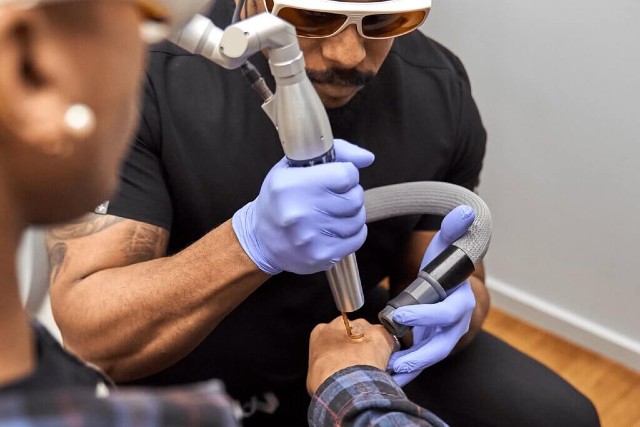Tattoos, once seen as permanent symbols of personal expression, are now undergoing a transformation thanks to advancements in tattoo removal technologies. Whether motivated by a change in taste, career considerations, or the need to erase a past reminder, the journey towards safe and successful tattoo removal requires careful consideration and informed choices.
Understanding the Process
Tattoo removal is a multi-step process that involves breaking down the ink particles within the skin so that the body’s natural processes can eliminate them. Different methods, including laser removal, surgical excision, dermabrasion, and topical creams, cater to various tattoo types, sizes, and individual preferences. Understanding these processes is crucial in making informed decisions about the removal method that best aligns with your goals.
1. Laser Tattoo Removal
Laser tattoo removal stands out as the gold standard in the industry. How does tattoo removal work? It utilizes specialized lasers to target and break down tattoo ink particles. The broken-down ink is then naturally eliminated by the body’s lymphatic system. This method is versatile, effective, and suitable for a wide range of tattoos.
To ensure safe and successful laser removal, it’s essential to choose a reputable and experienced practitioner. The number of sessions required depends on factors such as tattoo size, ink color, and individual skin characteristics. Patience is key, as results are not immediate, and multiple sessions are typically needed for optimal fading.
2. Surgical Tattoo Removal
Surgical tattoo removal involves physically cutting out the tattooed skin and stitching the surrounding skin back together. While this method provides immediate results, it often results in some scarring. Surgical removal is generally reserved for smaller tattoos due to the complexity of the procedure.
Success in surgical removal depends on the skill of the surgeon and the aftercare provided. Proper wound care is crucial to minimize scarring, and individuals considering this method should be prepared for a longer recovery period compared to non-invasive techniques.
3. Dermabrasion
Dermabrasion is a mechanical method that involves “sanding” off the top layers of skin to reach the tattooed area. While it is less common than laser removal, dermabrasion can be effective, especially for tattoos closer to the skin’s surface.
This method can cause discomfort during the procedure and may require multiple sessions for optimal results. Dermabrasion is generally suitable for smaller tattoos, and individuals with certain skin conditions may need to explore alternative removal methods.
4. Topical Tattoo Removal Creams
Topical tattoo removal creams claim to fade tattoos gradually with regular application. These creams work by breaking down tattoo ink, encouraging it to fade over time. While convenient and non-invasive, it’s important to manage expectations, as results may vary, and complete removal is not guaranteed.
Safety is a key consideration with topical creams, and individuals with sensitive skin should perform a patch test before use. Results take time, and consistent application is necessary for any noticeable fading. Consulting with a dermatologist before using such products is advisable.
Choosing Safety
Regardless of the chosen removal method, safety is paramount. Professional consultation is a critical step in ensuring the process is safe and successful. A qualified practitioner will assess the tattoo, discuss your goals, and provide information on the expected number of sessions, potential side effects, and aftercare instructions.
During the consultation, it’s crucial to be open about your medical history and any existing skin conditions. This information helps the practitioner tailor the removal plan to your specific needs, minimizing the risk of complications.
Understanding Risks and Side Effects
While tattoo removal methods have become more advanced, it’s essential to recognize that no method is without risks or potential side effects. Laser removal, for instance, may cause temporary discomfort, redness, or blistering. Scarring is a potential concern with surgical removal, and dermabrasion can result in changes in skin pigmentation.
By understanding the potential risks and side effects associated with each method, individuals can make informed decisions and take necessary precautions to mitigate adverse outcomes.
Aftercare
Successful tattoo removal extends beyond the treatment sessions. Aftercare is a crucial component in ensuring the healing process is smooth and complications are minimized. Practitioners provide specific instructions on caring for the treated area, including avoiding sun exposure, refraining from picking at scabs, and using recommended ointments or creams.
Adhering to aftercare guidelines is instrumental in achieving the best possible results and minimizing the risk of complications such as infections or scarring.
Conclusion
Embarking on the journey of tattoo removal is a personal decision that requires careful consideration and informed choices. Safety and success in tattoo removal are achieved through professional guidance, realistic expectations, and commitment to aftercare.
By understanding the nuances of each removal method, consulting with experienced practitioners, and embracing the necessary aftercare, individuals can navigate the process with confidence. Tattoo removal is not just about erasing ink; it’s about embracing change, reclaiming skin, and moving forward with a fresh canvas for new expressions of identity.


